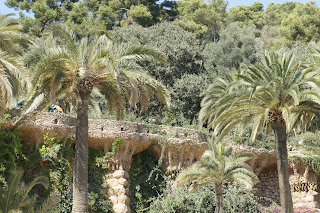Some time ago I promised a Spain garden special featuring photos from the trip to Europe in late August/September last year. My desire to show these pictures has been spurred on since reading Dee Nolan's wonderful book
A Food Lover's Pilgrimage to Santiago de Compostela (published by Penguin, Lantern). I knew I had I had to have this book after hearing Dee Nolan interviewed last year on the
'Dirty Deeds' gardening program on Melbourne independent FM station 3RRR (102.7). Her pilgrimage route took her from Arles in southern France (which I revisited after twenty years) to Santiago de Compostela in north western Spain, not far from the fishing port of Finisterre, thought in medieval times to be at the edge of the world.
The book takes on a number of themes, one of a personal emotional journey for the author but also looks at the importance of caring about what we eat and how food's produced. I find Nolan's approach to food affirms the importance of growing one's own and that's ultimately about having the freshest seasonal produce at hand, food that satisfies body and soul. An edited extract from the book can be found
here, from
Qantas The Australian Way magazine, December 2010.
Nolan's book focused on green and wet northern Spain and I may not walk the camino but I would really like to sample some of the places on the route. In contrast, our trip took in the sunnier places many would be more familiar with; the vibrant capital Madrid, Granada with its stunning Moorish architecture and buzzy Barcelona by the Mediterranean. Whilst it was a short trip we took in the time to look at parks and gardens, and the highlight of the whole trip had to be the Alhambra and to see one of the most beautiful gardens in the world, The Generalife.
Here is just a tiny selection of photos (we took heaps). I hope you enjoy and take inspiration from them as I have.
Rose garden, Parque de el Retiro, Madrid.
View of the magnificent Alhambra from the Albaicin, Granada.
On the walk up to the Alhambra.
Blue spikes of salvia, Patio de la Acequia, The Generalife, Granada.
The narrow pool and water spouts adds sparkle to the Patio de la Acequia.
Water spout, The Generalife.
Water is a key feature in the gardens of the Alhambra and The Generalife and an intricate irrigation system keeps its pools and fountains full. The Escalera de Aqua stair bannister doubles as an aqueduct that carries water down hill water to a lower section of the garden. I think I want one!
Near by the Nasrid Palace of the Alhambra.
Court of the Myrtles, Nasrid Palace.
Court of the Myrtles - simply stunning.
A Nasrid Palace courtyard, so cool and inviting on a hot summers day.
I love the incorporation of the greenery in the Font Monumental, Parc de la Ciutadella, Barcelona. Apparently Antonio Gaudi worked on it as an architecture student. He's the man behind the ambitious and yet to be complete Sagrada Familia. Love him - or hate him as George Orwell did - he's left a mark on the city in more ways than one.
You would be forgiven for mistaking this for the entrance of a surrealist's theme park. Not quite, but the entrance to Guadi's Parc Guell, Barcelona. Interestingly, I see elements of the Font Monumental here.
Parc Guell. Love the use of bold strappy plants.
Palms complement the terraces.
Ok, perhaps it is a surrealist's theme park after all.
Cheers.














































